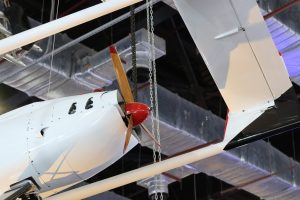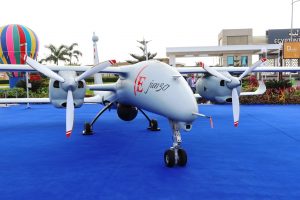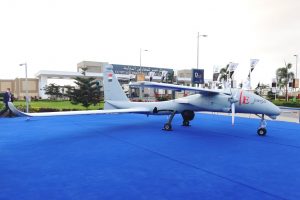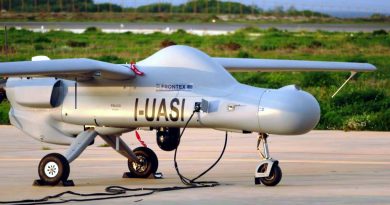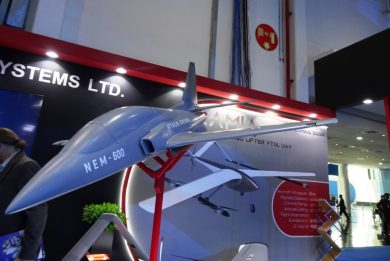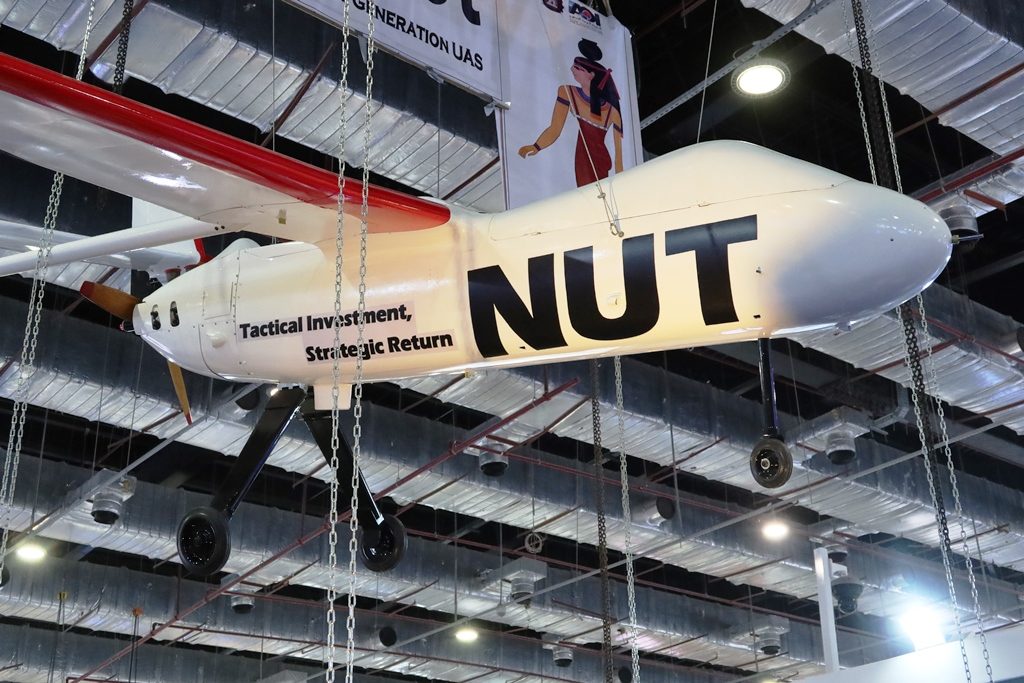
Egypt manufactured UAVs on show at EDEX
By Paolo Valpolini
The importance of UAVs for Egyptian Armed Forces is clearly shown by the fact that it is nearly impossible to get the figures of how many of them are in service, while something more is known about the models in use by the services. At the 2021 edition of EDEX at least two locally made UAVs were shown for the first time.
The smaller one, the Nut, the name of the ancient Egyptian goddess of the sky, was a Medium-Altitude Medium Endurance (MAME) and was hanging from the ceiling on top of the Arab Organization for Industrialization (AOI) booth. With a central fuselage hosting the payload, the electronics, and the internal combustion engine, it has a high wing with a 7.5 meters wingspan, and a double tail boom fixed to the wing that carry the horizontal tailplane and the two rudders. A three-blade pushing propeller linked to the engine provides propulsion, maximum level airspeed being 180 km/h while cruise speed is between 120 and 140 km/h, and at that speed the Nut has a 10 hours endurance, its tank containing 95-100 kg of fuel.
Cruise altitude is 5,000 meters, climbing speed being 5 m/s, while minimum loitering speed is 110 km/h. At take-off the UAV weighs 340 kg, and carries a 50 kg payload. The Nut is in service with the Egyptian forces and has been produced locally under license from China, which calls it ASN-209. According to personnel from the Military Technical College, this institution cooperating with AOI in the development of the drone, a new version is being manufactured, which mock-up was that hanging from the ceiling at EDEX. “We will work on the structure, in order to decrease weight thanks to the use of new materiel that will allow lowering the dry weight in order to increase both fuel and mission payload, while the shape will remain the same,” a technical officer told EDR On-Line. The target being to increase the payload up to 65 kg and the endurance to 14 hours, considering available figures of the original version this should mean an increase of around 35 kg of fuel plus 15 kg of added payload, a total of 50 kg to take of from the structure, current dry weight being around 190-200 kg, not an easy task for Egyptian engineers to reduce weight by 25%.
The new version should fly in one-year time. Rumours about the production of a further batch of Nut have been around for some time, but the recent information about an upgraded version might delay the manufacturing of the new batch in order to get the drone with improved performances. Beside increasing payload and endurance, the future Nut will also be fitted with a SATCOM data link, the bump in the front upper part of the fuselage being clearly hosting that antenna, and this will allow increasing the range, currently 200 km with the line-of-sight data link, to a much higher distance, the limit being now due to endurance and not anymore to data link range.
Moving one notch up, from MAME to MALE, hence Long Endurance, at the outside exhibition EDEX visitors could see the Jun 30, a twin engine UAV developed by the Industrial Complex Engineering Robots (ICER). The single fuselage is fitted with a high main wing, which carries the two engine nacelles, each engine activating a three-blade pulling propeller.
Moving backward we find a lower tailplane, which is in fact a wing in itself, as it has a greater wingspan and is fitted with winglets, absent on the front wing, and finally the single rudder. The gimballed electro-optical payload is located slightly ahead of the tailplane. According to data provided by ICER the Jun 30 is 8.9 meters long, 2.6 meters high, has a 12 meters wingspan, a maximum take-off weight of 1,400 kg and a 270 kg payload. It can fly for 24 hours, depending on configuration, at altitudes up to 7,000 meters, at a maximum speed of 260 km/h, cruise speed being between 120 and 240 km/h depending on the mission.
Take-off and landing are automatic, respective speeds being 135 and 120 km/h. Two 20-fet shelters hosted respectively the ground control station and the data link. How much the Jun 30 is a fully Egyptian development or not remains undisclosed, no comments being made by the company representatives. Some similarities may indicate a possible transfer of technology from the UAE, however discrepancies in some physical measures and performance suggest that the Jun 30 should not be a blueprint copy of some existing drone.
Photos by P. Valpolini



